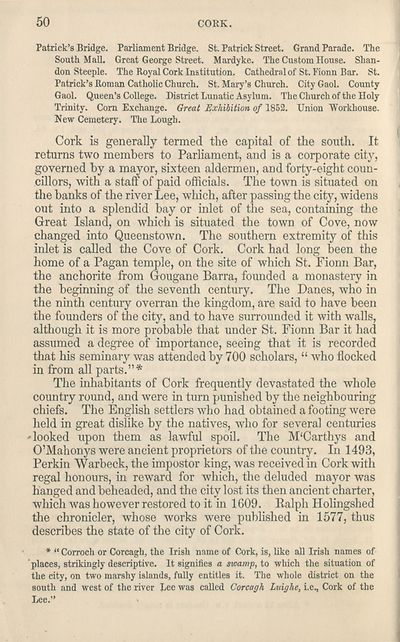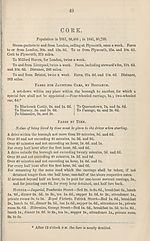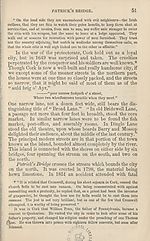Download files
Complete book:
Individual page:
Thumbnail gallery: Grid view | List view

50 CORK.
Patrick’s Bridge. Parliament Bridge. St. Patrick Street. Grand Parade. The
South Mall. Great George Street. Mardyke. The Custom House. Shan-
don Steeple. The Royal Cork Institution. Cathedralof St.Fionn Bar. St.
Patrick’s Roman Catholic Church. St. Mary’s Church. City Gaol. County
Gaol. Queen’s College. District Lunatic Asylum. The Church of the Holy
Trinity. Com Exchange. Great Exhibition of 1852. Union Workhouse.
New Cemetery. The Lough.
Cork is generally termed the capital of the south. It
returns two members to Parliament, and is a corporate city,
governed by a mayor, sixteen aldermen, and forty-eight coun¬
cillors, with a staff of paid officials. The town is situated on
die banks of the river Lee, which, after passing the city, widens
out into a splendid bay or inlet of the sea, containing the
Great Island, on which is situated the town of Cove, now
changed into Queenstown. The southern extremity of this
inlet is called the Cove of Cork. Cork had long been the
home of a Pagan temple, on the site of which St. Fionn Bar,
the anchorite from Gougane Barra, founded a monastery in
the beginning of the seventh century. The Danes, who in
the ninth century overran the kingdom, are said to have been
the founders of the city, and to have surrounded it with walls,
although it is more probable that under St. Fionn Bar it had
assumed a degree of importance, seeing that it is recorded
that his seminary was attended by 700 scholars, “ who flocked
in from all parts.”*
The inhabitants of Cork frequently devastated the whole
country round, and were in turn punished by the neighbouring
chiefs. The English settlers who had obtained a footing were
held in great dislike by the natives, who for several centuries
•looked upon them as lawful spoil. The M'Carthys and
O’Mahonys were ancient proprietors of the country. In 1493,
Perkin Warbeck, the impostor king, was received in Cork with
regal honours, in reward for which, the deluded mayor was
hanged and beheaded, and the city lost its then ancient charter,
which was however restored to it in 1609. Ralph Holingshed
the chronicler, whose works were published in 1577, thus
describes the state of the city of Cork.
* “Corroch or Corcagli, the Irish name of Cork, is, like all Irish names of
places, strikingly descriptive. It signifies a swamp, to which the situation of
the city, on two marshy islands, fully entitles it. The whole district on the
south and west of the river Lee was called Corcagh Luighe, i.e, Cork of the
Lee.’’
Patrick’s Bridge. Parliament Bridge. St. Patrick Street. Grand Parade. The
South Mall. Great George Street. Mardyke. The Custom House. Shan-
don Steeple. The Royal Cork Institution. Cathedralof St.Fionn Bar. St.
Patrick’s Roman Catholic Church. St. Mary’s Church. City Gaol. County
Gaol. Queen’s College. District Lunatic Asylum. The Church of the Holy
Trinity. Com Exchange. Great Exhibition of 1852. Union Workhouse.
New Cemetery. The Lough.
Cork is generally termed the capital of the south. It
returns two members to Parliament, and is a corporate city,
governed by a mayor, sixteen aldermen, and forty-eight coun¬
cillors, with a staff of paid officials. The town is situated on
die banks of the river Lee, which, after passing the city, widens
out into a splendid bay or inlet of the sea, containing the
Great Island, on which is situated the town of Cove, now
changed into Queenstown. The southern extremity of this
inlet is called the Cove of Cork. Cork had long been the
home of a Pagan temple, on the site of which St. Fionn Bar,
the anchorite from Gougane Barra, founded a monastery in
the beginning of the seventh century. The Danes, who in
the ninth century overran the kingdom, are said to have been
the founders of the city, and to have surrounded it with walls,
although it is more probable that under St. Fionn Bar it had
assumed a degree of importance, seeing that it is recorded
that his seminary was attended by 700 scholars, “ who flocked
in from all parts.”*
The inhabitants of Cork frequently devastated the whole
country round, and were in turn punished by the neighbouring
chiefs. The English settlers who had obtained a footing were
held in great dislike by the natives, who for several centuries
•looked upon them as lawful spoil. The M'Carthys and
O’Mahonys were ancient proprietors of the country. In 1493,
Perkin Warbeck, the impostor king, was received in Cork with
regal honours, in reward for which, the deluded mayor was
hanged and beheaded, and the city lost its then ancient charter,
which was however restored to it in 1609. Ralph Holingshed
the chronicler, whose works were published in 1577, thus
describes the state of the city of Cork.
* “Corroch or Corcagli, the Irish name of Cork, is, like all Irish names of
places, strikingly descriptive. It signifies a swamp, to which the situation of
the city, on two marshy islands, fully entitles it. The whole district on the
south and west of the river Lee was called Corcagh Luighe, i.e, Cork of the
Lee.’’
Set display mode to:
![]() Universal Viewer |
Universal Viewer | ![]() Mirador |
Large image | Transcription
Mirador |
Large image | Transcription
| Antiquarian books of Scotland > Ireland/Irish > Black's guide to Killarney and the south of Ireland > (62) |
|---|
| Permanent URL | https://digital.nls.uk/118861412 |
|---|
| Description | Thousands of printed books from the Antiquarian Books of Scotland collection which dates from 1641 to the 1980s. The collection consists of 14,800 books which were published in Scotland or have a Scottish connection, e.g. through the author, printer or owner. Subjects covered include sport, education, diseases, adventure, occupations, Jacobites, politics and religion. Among the 29 languages represented are English, Gaelic, Italian, French, Russian and Swedish. |
|---|

